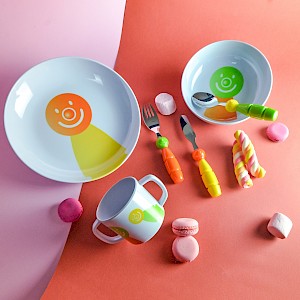Forks, spoons, knives, spatulas, ice cream scoopers – there’s just too many to count! When it comes to kitchen utensils, it’s safe to say that there are lots out there. Using kitchen utensils in a variety of games can help to develop your child’s language skills in many ways!

Activity Ideas
Touchy Feely Bag
Fill a bag with different kitchen utensils and ask your child to describe them to you. You can talk about different categories such as size (e.g. big, small, thin, long), shape (e.g. pointy, smooth, handle or no handle), material (e.g. plastic, metal) and texture (e.g. bumpy, smooth, has holes).
After your child has described the object, ask them to guess what it might be for! Help them along by making suggestions (e.g. “this one is like a spoon but has holes in it. If we dipped the spoon in water, would the water stay in the spoon? … Let’s see how it works!”).
Playdoh
If you have any old utensils laying around, you can encourage your child to use them with playdoh. As a substitution, you could compare newer utensils to playdoh equipment to keep them clean. Let your child experiment with how to use each utensil. As they do this, talk about what they’re doing. This is a great chance to model the names of objects as well as doing and describing words (e.g. “that knife is thin and long – that helps it chop the playdoh”; “if we push the masher onto the playdoh, see how the playdoh gets squeezed through the holes?”).
Playing with utensils and playdoh can be a great time to let your child practice following instructions. Start with smaller instructions and build your way up to bigger instructions, especially if you’re including unfamiliar objects and words.
2 key words: chop the playdoh
3 key words: squish the playdoh with the knife
4 key words: roll out the playdoh with the rolling pin and prick it
Utensil Tracing
Tracing around utensils can be a great opportunity to teach your child about different shapes. You can talk about shapes themselves (e.g. circle, square), as well as use other words to describe the shapes (e.g. long, thin, thick, straight, curved).
Chef
Play an imaginary game of “chef” with your child or get them to help you prepare dinner or make a fun snack like cookies. Run through each utensil at the start so your child is familiar with each utensil’s name. When cooking, model different doing and describing words to help your child understand what the utensils do. To target your child’s understanding of different utensils, you can ask them what utensil would be best for a certain step (e.g. “what one should be use to beat the eggs?”; “what certain type of spoon do we need to get the ice cream out?”) and ask them to show you how to complete the step (where safe!).
There are lots of different ways you can include utensils in fun activities. Talking about the name of utensils, what they do and how they look or feel can help build your child’s understanding and use of language, as well as their understanding of how to use the utensils!
Related Blog Posts
If you liked this post you may also like:
3 1/2 year olds
10 waiting room skills
Top language ideas
Transitioning To School



